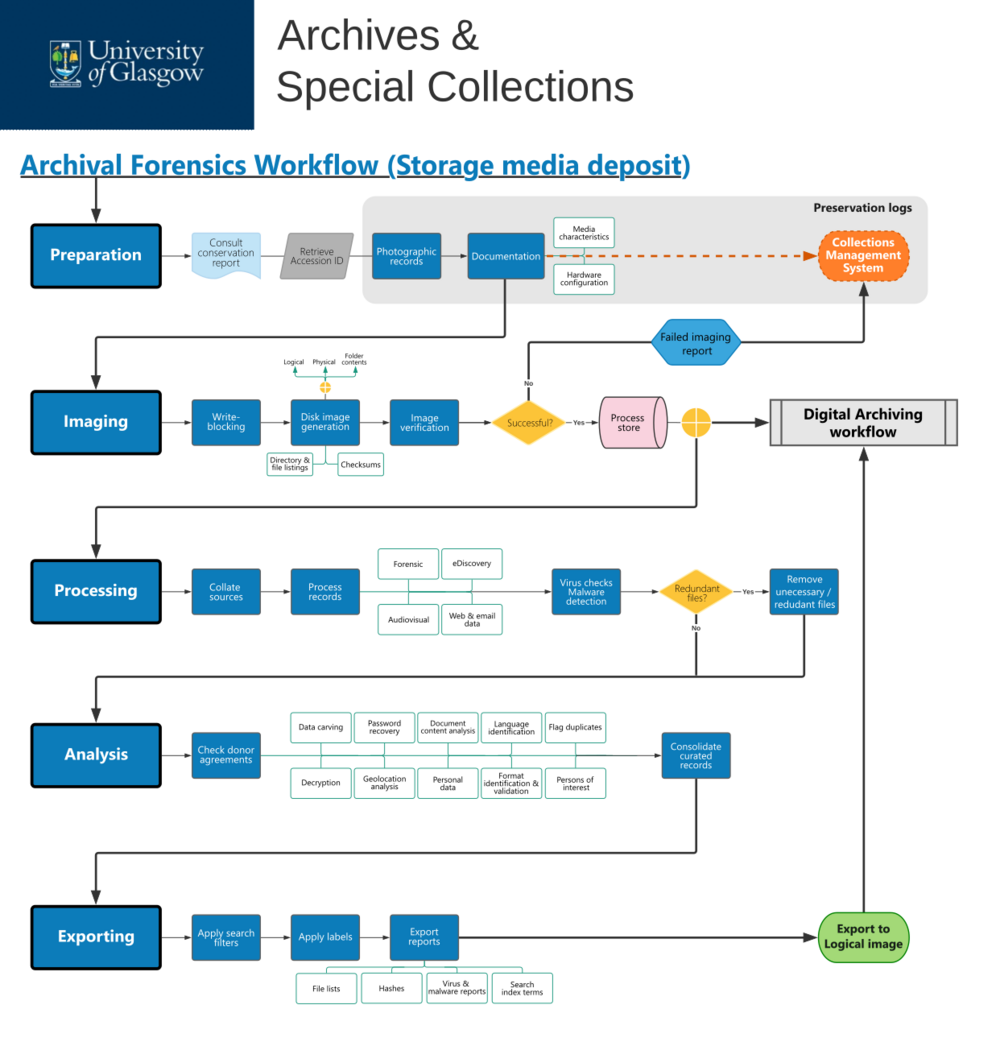Workflow:Archival Forensics workflow (storage media deposit)
Jump to navigation
Jump to search
Workflow Description
- START
- A request to forensically process a digital deposit (storage media) to the University of Glasgow Archives & Special Collections, as part of of the Digital Archiving workflow.
- PRE-ACQUISITION APPRAISAL
- Processes for evaluating whether a deposit request will be accepted by the University Archives.
- Check the deposit request against the Archives & Special Collections collection development policy - does the request align with the core collecting areas?
- Prepare a records survey and/or pre-accession assessment of the proposed deposit.
- Evaluate the results of the records survey against the Appraisal & Retention policy, which:
- addresses issues pertaining to selection and long-term retention of digital objects
- extends the collections development policy
- ensures that retention decisions are balanced between value and capacity to preserve for the long-term; and
- provides clarity to avoid assumptions over digital storage costs and availability.
- Decide whether the requested deposit aligns with policies:
- If not, re-evaluate acquisition and/or reject deposit.
- If yes, proceed to Acquisition.
- ACQUISITION
- Processes for acquiring digital materials by transfer, donation, or purchase.
- Follow the methodology in the Space data and information transfer systems — Producer-archive interface — Methodology abstract standard (PAIMAS) ISO 20652:2006 standard. The standard "identifies, defines and provides structure to the relationships and interactions between an information producer and an archive. It defines the methodology for the structure of actions that are required from the initial time of contact between the producer and the archive until the objects of information are received and validated by the archive." (ISO). For more information, see Acquisition and appraisal, Digital Preservation Handbook (DPC).
- Follow the Accepted file formats/media procedure, which:
- Specifies decisions on file formats and/or storage media that the University Archives will accept.
- Aligns with preservation planning decisions for format normalisation; and capability to access storage media (esp. legacy media, e.g. floppy or zip disks).
- For a summary table of options, see the Acquisition workflow section in Acquisition and appraisal, Digital Preservation Handbook (DPC).
- For acquisitions deposited in physical storage media:
- Place all incoming items in quarantine area on arrival, inspect for pest infestation and mould; and follow handling and moving procedures.
- Create physical conservation and preservation report, documenting all actions on the acquired media.
- Proceed to Accessioning.
- For acquisitions deposited digitally (e.g. file transfer):
- Proceed to Accessioning.
- ACCESSIONING
- Process of formally registering deposit into the University Archives, which enables intellectual control over the digital materials.
- Generate a unique accession number, based on the University Archives' archival processing guidelines.
- Compare the file manifests generated during Acquisition to make sure that the transfer includes everything that was deposited by the source.
- List the accession number into the University's Collections Management System for cataloguing. Cataloguing processes include decisions over the system of arrangement and level of description that will be used for the deposited materials; definition of access and reproduction conditions; and documentation via descriptive metadata.
- Decide whether archival forensic processing is required:
- If Yes, follow the Archival Forensics workflow.
- Proceed to Transfer.
- TRANSFER
- Processes for transferring digital materials to the University Archives.
- Choose a method for transferring files:
- Copy files from source media. OR
- Create a disk image from source storage media. OR
- Request that digital materials are submitted as a BagIt container.
- Check digital materials for viruses. See Select and transfer workflow in the TNA guide (section 1.3) for a reasonable process. Depending on the results of virus checks:
- if virus is found, quarantine and attempt removal; and/or request clean versions from source. If all these fail, prepare a report documenting actions and re-evaluate acquisition.
- if virus-free, proceed with transfer.
- Generate checksums to verify data integrity during transmission and/or storage:
- For digital acquisitions in situ, it might be appropriate to first store files in a temporary location for virus and/or integrity checks, before transferring to process store. Not applicable to all scenarios.
- Transfer digital materials to Process store (e.g. network drive).
- Use tools to identify file types and validate file formats (e.g. DROID, JHOVE), then proceed to Appraisal.
